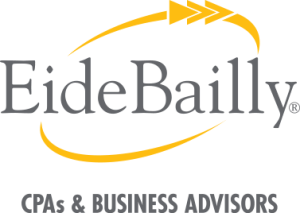 Member guest blog post, submitted by EideBailly. This article originally appeared on EideBailly.com
Member guest blog post, submitted by EideBailly. This article originally appeared on EideBailly.com
The government has released several updates to its Paycheck Protection Program (PPP) loan forgiveness guidance over the last few weeks. Here is a brief summary to help guide you through the PPP loan forgiveness process.
Eligible Costs: Paid and Incurred
Payroll costs incurred before a borrower’s covered period, but paid during the covered period, qualify as eligible expenditures. Example: A borrower with a covered period beginning on April 20 can include payroll paid on April 24 as an eligible expenditure. However, employer contributions for retirement benefits do not count as eligible expenditures if they are “accelerated from periods outside” the borrower’s covered period or alternative covered period.
Eligible non-payroll costs incurred before the start of the borrower’s covered period, but paid during the covered period, also count as eligible expenditures.
Both eligible payroll and non-payroll costs incurred during a borrower’s covered period but paid after the end of the covered period on the next regularly scheduled date count as eligible expenditures (but only the incurred portion).
Payroll Costs: Owners
Owner-employees and self-employed individuals are subject to additional restrictions. For borrowers using a 24-week covered period, owner-employees and self-employed individuals’ compensation is capped at the lesser of $20,833 or 2.5-months of 2019 compensation. For borrowers using an 8-week covered period, the cap is the lesser of $15,385 or the 8-week equivalent of applicable compensation in 2019.
Additional rules:
C corporation owner-employees: employer health insurance and retirement contributions are eligible additional expenditures, but the retirement costs cannot exceed 2.5/12 of 2019 amounts.
S corporation owner-employees owning at least 2% of the S corporation: employer health insurance contributions are not included, but employer retirement contributions do count (the retirement costs cannot exceed 2.5/month of 2019 amounts).
Self-employed individuals and general partners: employer health insurance and retirement contributions are not included as eligible expenditures.
Owner-employees with less than a 5% ownership stake in a C- or S-corporation are not subject to the owner-employee compensation rules.
These rules do not restrict the amount of compensation a borrower can pay to an owner-employee; they only cap the amount of expenditures that are included in the forgiveness calculation.
Subleasing and Related Party Rents
The amount of eligible rent expense cannot include any amount attributable to the business operations of a tenant or subtenant. Example: a borrower with a $10,000 monthly rent payment who subleases a portion of the rented space for $2,500 can only include $7,500 as an eligible rental expenditure.
The government provides restrictive rules for related party rental situations where a business pays rents to a related property owner. Common ownership between the business and property owner is a related party. If there are related parties, loan forgiveness for rent or lease payments to a related party “is no more than the amount of mortgage interest owed on the property during the Covered Period that is attributable to the space being rented by the business.”
Next Steps
The recently released updates may have a material impact on eligible borrowers choosing the 8-week covered period because borrowers do not have additional time to generate more eligible expenditures. Borrowers using the 24-week covered period may find these updates less burdensome. Proposed legislation, once enacted, may change this whole program once again by simplifying the forgiveness stage.




